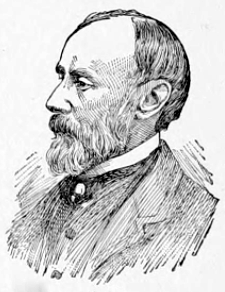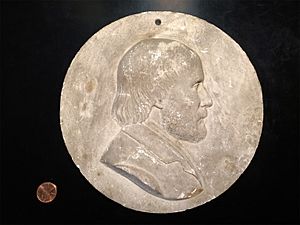Sydney Howard Gay facts for kids
Quick facts for kids
Sydney Howard Gay
|
|
|---|---|
 |
|
| Born | May 22, 1814 Hingham, Massachusetts
|
| Died | June 25, 1888 (aged 74) New Brighton, Staten Island
|
| Occupation | Lawyer, journalist |
| Spouse(s) |
Elizabeth Johns Neall
(m. 1845) |
| Children | Mary Otis Gay Willcox |
| Signature | |
Sydney Howard Gay (1814–1888) was an American lawyer and journalist. He was also a strong abolitionist, meaning he worked to end slavery. He was very active in New York City.
Starting in 1843, he worked as the editor of the National Anti-Slavery Standard newspaper for 14 years. His office became a secret stop on the Underground Railroad. This was a network of safe houses and routes that helped enslaved people escape to freedom. Sydney Howard Gay worked with many others to help these brave people.
He worked closely with Louis Napoleon, a free Black man. For about two years, Gay kept detailed notes about the nearly 200 people they helped. These notes are known as the Record of Fugitives. Gay helped people coming from Philadelphia, so his notes sometimes matched those of another activist named William Still. Still published his own records in 1872.
Gay's Record was found much later, in the early 2000s, among his papers at Columbia University. It's believed that Gay and Napoleon helped around 3,000 people escape slavery. Many of them found freedom in upstate New York and Canada. His Record shows how big and organized the Underground Railroad truly was, with hundreds of people helping out.
Contents
Growing Up: Sydney Gay's Early Life
Sydney Gay was born on May 22, 1814, in Hingham, Massachusetts. His father, Ebenezer Gay, was a lawyer. His mother, Mary Alleyne Otis, was related to famous American Revolution activists. On his father's side, Sydney was a descendant of Governor William Bradford. Bradford was a founder of the Plymouth Colony and arrived on the Mayflower in 1620.
Sydney's father wanted one of his sons to become a lawyer like him. Sydney's older brothers didn't follow this path. So, his father sent Sydney to Harvard College to study law. But Sydney was only 15 and found it hard to be away from home. He got sick and had to leave his classes. His father was sad when Sydney didn't want to go back.
Sydney wanted to be a businessman instead. He borrowed money from his father for several business ideas, but they didn't work out. While trying to start a business in New Orleans, his sister told him about Angelina Grimké. She was an abolitionist who spoke against slavery and impressed their mother. At first, Sydney thought abolitionists were too extreme.
When his New Orleans business failed, Sydney returned home feeling unwell and ashamed. He spent time in his father's library, reading and thinking deeply about slavery. He changed his mind and became an abolitionist himself. His father still hoped he would become a lawyer. However, Sydney refused to take the lawyer's oath because the U.S. Constitution allowed slavery at the time.
Sydney then joined the local Antislavery Society. He also started writing articles against slavery for the Hingham Patriot newspaper. He joined William Lloyd Garrison's American Abolition Society. He even traveled with Frederick Douglass, a famous abolitionist who had escaped slavery.
Life in New York City: A New Chapter
In 1843, Sydney Gay moved to New York City. He became the editor of the National Anti-Slavery Standard, an important newspaper for the abolitionist movement. He held this job for 14 years.
Two years later, in 1845, Sydney married Elizabeth Johns Neall. Her grandfather, Warner Mifflin, and father, Daniel Neall, were also well-known Quaker abolitionists. Elizabeth was also an abolitionist and supported women's rights. Their daughter, Mary Otis Gay Willcox, later became an important community worker on Staten Island.
Helping Others: The Underground Railroad
Sydney Gay's office at the Standard became one of the busiest stops on the Underground Railroad in New York City. Many people helped him. These included Isaac T. Hopper and his daughter Abigail Hopper Gibbons. Two African Americans were also key helpers: William H. Leonard, the Standard's printer, and Louis Napoleon. Louis Napoleon helped many freedom seekers who were sent to Gay's office from Philadelphia.
Gay's office was a very important stop for people traveling from Philadelphia. From there, they could go to New Haven and Boston, or to Canada West (now part of Canada) through cities like Albany, Syracuse, and Rochester.
Gay even helped three famous freedom seekers: Henry "Box" Brown, Jane Johnson, and Harriet Tubman. In two notebooks, called Record of Fugitives, 1855—, he wrote down the stories of over 200 people he and his friends helped between 1855 and 1856. Since Gay helped some of the same people as William Still in Philadelphia, Gay's Record is a very important historical document.
Historians didn't find Gay's Record until the 2000s. It was first mentioned by historian Kathryn Grover in 2002. Tom Calarco later found the Records and had them photographed for research. He quickly realized how important they were. He worked with Don Papson on a book about these documents, which came out in 2015.
Around the same time, other historians, like Eric Foner, also learned about the Records. You can see a copy of Gay's Record of Fugitive Slaves online through the Columbia University Library. Eric Foner also wrote a book about the Underground Railroad called Gateway to Freedom: The Hidden History of the Underground Railroad (2015). He believes that Sydney Gay and his helpers in New York aided about 3,000 enslaved people in reaching freedom.
Sydney Gay's Journalism Career
After 14 years at the Standard, Gay left his job. He was tired and needed more money to support his family. However, he continued to help freedom seekers and stayed on the American Anti-Slavery Society's board.
After resting at his home on Staten Island, Gay took a job at Horace Greeley's New-York Tribune newspaper. He became the managing editor. Even though Greeley often criticized President Lincoln during the Civil War, Gay made sure the Tribune supported the Union. During the 1863 Draft Riots, Gay went against Greeley's orders and armed his staff. This helped them stop a mob from burning down the Tribune building.
After the war, Greeley moved Gay to a lower position, so Gay resigned. He was very tired. After a long rest, he accepted a job at the Chicago Tribune in 1867. He lived and worked there until after the Great Chicago Fire of 1871.
Gay then returned to New York. He worked for the New York Evening Post from 1872 to 1874. Later, he worked for William Cullen Bryant's Evening News. Bryant asked him to help write a multi-volume book called Popular History of the United States for Scribners. Gay did most of the writing for this big project.
Later Years and Legacy
In 1877, Harvard recognized Sydney Gay's achievements by giving him a special diploma.
He was chosen as a member of the American Antiquarian Society in 1878.
In 1884, Gay finished writing A Life of James Madison. He was working on a book about his abolitionist friend, John Quincy, when he fell and hurt his spine. This injury caused him to become paralyzed. He passed away in New Brighton, Staten Island on June 25, 1888. He was buried in Hingham Cemetery with his ancestors.
Sydney Howard Gay's papers, known as the Gay Papers, are kept at the Rare Book & Manuscript Library at Columbia University. This is where his important Record of Fugitives was found in the early 2000s. Two books based on these records were published in 2015, helping us learn even more about the Underground Railroad.
Images for kids



